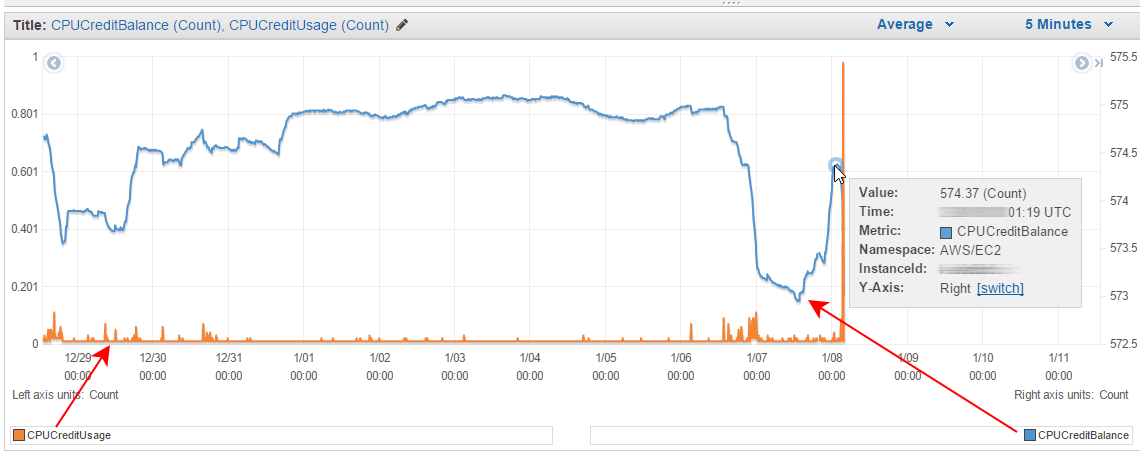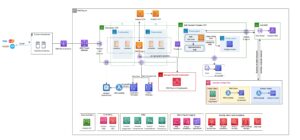AWS CPU credits are a unit of measurement used to determine the amount of CPU resources available to an Amazon Web Services (AWS) instance. CPU credits are earned at a specified rate over time and can be used when the instance requires more CPU resources than the baseline performance level.
In the world of cloud computing, managing and optimizing CPU usage is crucial for cost efficiency and performance. AWS CPU credits play a significant role in this process by allowing instances to burst beyond their baseline performance when needed, without incurring additional costs.
Understanding how CPU credits work and how to effectively manage them can help AWS users optimize their instances’ performance while minimizing expenses. By leveraging CPU credits, users can ensure their applications have the necessary computing power when demand spikes, without overspending on resources during periods of low utilization.

Credit: www.concurrencylabs.com
Introduction To Aws Cpu Credits
AWS CPU credits are a valuable resource for managing burstable performance instances efficiently. These credits accumulate when the instance runs below baseline performance. When the instance requires more power, it consumes these credits to maintain optimal performance levels.
The Concept Of Cpu Credits
AWS CPU credits are a fundamental part of Amazon Web Services (AWS) and play a crucial role in determining the performance and cost of your cloud-based applications. Understanding CPU credits is essential for optimizing resource allocation and ensuring efficient utilization of your AWS instances. In this section, we will delve into the concept of CPU credits and how they impact cloud computing.
Importance In Cloud Computing
In cloud computing, CPU credits act as a currency for accessing CPU resources. They are used to measure the amount of processing power available to your instances. CPU credits are accumulated over time, allowing bursts of high CPU usage when needed. This concept is particularly relevant for applications that exhibit variable workloads, as it enables them to utilize additional resources during peak periods without compromising performance or incurring excessive costs.
By effectively managing CPU credits, you can optimize the performance and cost of your AWS instances. Instances with a higher CPU credit balance can handle bursty workloads more efficiently, ensuring your applications operate smoothly during peak demand. On the other hand, instances with low CPU credits may experience performance degradation or even be throttled, resulting in slower response times and potential disruptions.
It is important to note that the accumulation and depletion of CPU credits are dependent on the instance type. For example, T2 and T3 instance types are designed for burstable workloads and rely heavily on CPU credits. These instances accrue credits during low-usage periods and consume them during high-usage periods. Understanding the CPU credit system allows you to select the appropriate instance type and monitor credit balances to ensure optimal performance and cost efficiency for your applications.
In conclusion, AWS CPU credits are an integral part of cloud computing on the AWS platform. They provide a mechanism for managing CPU resources and balancing performance with cost. By understanding the concept of CPU credits and their importance in cloud computing, you can make informed decisions about resource allocation and optimize the performance of your AWS instances.
How Cpu Credits Work
AWS CPU credits are a crucial aspect of managing the performance of your EC2 instances. Understanding how CPU credits work is essential for ensuring that your instances operate optimally and cost-effectively.
Acquiring Credits
When your EC2 instance is running below the baseline performance level, it accrues CPU credits. These credits are accumulated at a steady rate and can be stored for future use. This allows your instance to build up a reserve of credits during periods of low activity.
Consuming Credits
During bursts of high CPU usage, your instance consumes credits to maintain its performance levels above the baseline. When the credit balance is exhausted, the instance’s performance is capped at the baseline level, unless additional credits are acquired or purchased.
Eligible Instances For Cpu Credits
When it comes to AWS, CPU credits are a way of measuring the amount of processing power that an instance uses. The credits are used to provide burstable performance for instances that don’t require a lot of CPU power on a consistent basis. This can save you money, as you only pay for the CPU power that you use. However, not all instances are eligible for CPU credits. In this article, we’ll take a look at the eligible instances for CPU credits, focusing on the T2, T3, and T3a instances.
T2 Instances
T2 instances are burstable performance instances that are designed for workloads that don’t require a lot of CPU power on a consistent basis. These instances are eligible for CPU credits, which are used to provide additional CPU power when needed. The amount of CPU credits that you receive depends on the size of the instance and how long it has been running. T2 instances are a good choice for applications that have variable workloads, as they can provide additional CPU power when needed without incurring additional costs.
T3 And T3a Instances
T3 and T3a instances are the next generation of burstable performance instances. These instances are designed to provide a balance of compute, memory, and network resources, making them a good choice for a wide range of workloads. Like T2 instances, T3 and T3a instances are eligible for CPU credits. However, the way that CPU credits are calculated is slightly different. With T3 and T3a instances, you receive a baseline level of CPU performance, and then additional CPU credits can be used to provide burstable performance when needed.
In conclusion, CPU credits are a useful way of providing burstable performance for instances that don’t require a lot of CPU power on a consistent basis. T2, T3, and T3a instances are all eligible for CPU credits, making them a good choice for applications that have variable workloads. By using CPU credits, you can save money on your AWS bill, as you only pay for the CPU power that you use.

Credit: stackoverflow.com
Monitoring Cpu Credit Balance
Monitoring CPU credit balance is essential for ensuring that your AWS EC2 instances do not run out of credits, which can lead to performance issues and downtime. AWS provides a set of tools and metrics that you can use to monitor your CPU credit balance and prevent any issues.
Aws Cloudwatch
AWS CloudWatch is a monitoring service that provides metrics, logs, and alarms for AWS resources and applications. It provides a set of metrics that you can use to monitor your EC2 instance’s CPU credit balance, including:
- CPU Credit Usage: The number of CPU credits consumed by your instance.
- CPU Credit Balance: The number of CPU credits available for your instance to use.
- CPU Utilization: The percentage of CPU utilization for your instance.
You can use these metrics to create CloudWatch alarms that notify you when your CPU credit balance is running low or when your CPU utilization is high, indicating that your instance may be running out of credits.
Understanding The Metrics
It’s important to understand the metrics provided by CloudWatch to effectively monitor your CPU credit balance. The CPU credit usage and balance metrics are measured in CPU credits, which represent the number of vCPU seconds that your instance can use in a burstable performance instance family.
The CPU utilization metric is measured as a percentage of the total vCPUs available to your instance. For example, if your instance has two vCPUs and is utilizing one vCPU at 50%, the CPU utilization metric will be 50%.
By monitoring these metrics, you can ensure that your instance has enough CPU credits to operate smoothly and avoid any performance issues or downtime.
Cpu Credits And Performance
CPU credits on AWS are a vital resource for maintaining performance levels. They accumulate when workloads are below baseline, ensuring consistent performance during peak usage. Understanding CPU credits helps optimize performance and manage costs effectively on the AWS platform.
Impact On Instance Performance
Understanding the concept of CPU credits is crucial for optimizing the performance of your AWS instances. CPU credits play a significant role in determining the processing power and overall performance of your virtual machine. By delving into how CPU credits impact instance performance, you can make informed decisions to ensure your applications and workloads run smoothly.
When it comes to AWS, instances accumulate CPU credits when they are idle or have spare compute capacity. These credits act as a form of currency that can be spent when your instances require more processing power. The number of CPU credits you accumulate depends on the instance type and size, and AWS provides a baseline amount of credits to each instance. As your instance’s CPU utilization increases, it consumes CPU credits to maintain its performance.
It’s important to note that the accumulation and consumption of CPU credits directly affect the performance of your instances. If your instance is constantly running low on CPU credits, it may experience a decrease in performance, resulting in slower response times and potential bottlenecks. Monitoring your CPU credits usage is essential to ensure your instances have sufficient resources to handle your workload demands.
Optimizing For Efficiency
To optimize your AWS instances for efficiency, it’s crucial to understand how CPU credits work and implement strategies to manage them effectively. By optimizing your CPU credit usage, you can maximize your instance’s performance and minimize potential performance issues.
Here are some key strategies to optimize CPU credits and improve efficiency:
- Right-sizing your instances: Choosing the appropriate instance type and size based on your workload requirements can help ensure you have enough CPU credits to support your applications.
- Monitoring CPU credit balance: Regularly monitoring your instance’s CPU credit balance allows you to identify if your instance is consistently running low on credits and take necessary actions to prevent performance degradation.
- Implementing burstable performance instances: Utilizing burstable performance instances, such as the T3 instances, can be cost-effective for workloads that experience intermittent spikes in CPU utilization. These instances accumulate CPU credits during idle periods and use them during bursts of high activity.
- Using CPU credit metrics: Leveraging AWS CloudWatch metrics related to CPU credits can provide insights into your instance’s performance and help you make informed decisions regarding capacity planning and optimization.
By implementing these strategies, you can optimize your instance’s CPU credit usage, enhance performance, and ensure a smooth experience for your applications and users.
Managing Cpu Credits
Managing CPU Credits in AWS is crucial for optimizing the performance and cost-efficiency of your instances. By effectively managing CPU credits, you can ensure that your instances maintain consistent performance without incurring unnecessary costs.
Credit Spend Strategies
Implementing efficient credit spend strategies can help you maximize the utilization of CPU credits, ensuring that your instances operate optimally without experiencing CPU credit depletion. One effective strategy involves utilizing burstable instances during periods of high demand and leveraging other instance types during periods of low utilization.
Credit Balance Management
Proactively managing the credit balance of your instances is essential for avoiding unexpected performance degradation. By monitoring your instance’s credit balance, you can anticipate potential CPU credit shortages and take preemptive measures to prevent performance issues.
Cost Implications Of Cpu Credits
AWS CPU credits are a cost-saving feature that helps manage CPU utilization for burstable performance instances. When the CPU credit balance is high, it indicates lower costs, but if it runs low, additional charges may apply. Monitoring CPU credit balance is crucial to optimize costs and maintain performance efficiency in AWS environments.
Pricing Models
CPU credits in AWS have different pricing models based on usage.Cost-saving Tips
Optimizing CPU usage can help reduce costs significantly.Best Practices For Cpu Credit Usage
AWS CPU credits are a crucial aspect of managing your Amazon EC2 instances efficiently. By understanding the best practices for CPU credit usage, you can optimize performance and cost-effectiveness for your workloads. Let’s delve into some key strategies to make the most out of your CPU credits.
Workload Analysis
- Identify peak usage times and resource requirements.
- Monitor CPU credit balance regularly.
- Adjust instance types based on workload demands.
Instance Selection
- Choose instance types that match your workload characteristics.
- Utilize burstable instances for variable workloads.
- Consider T3 instances for balanced performance and cost savings.

Credit: www.cloudinsidr.com
Frequently Asked Questions
What Is Cpu Credit Balance In Aws?
CPU credit balance in AWS refers to the number of credits available for burstable performance instances. These instances accumulate credits when they operate below the baseline performance level. When the instance needs to burst beyond the baseline, it uses the accumulated credits.
This balance determines the duration of burstable performance.
What Happens When Cpu Credits Run Out?
When CPU credits run out, your CPU usage is restricted and your application’s performance is reduced. This can cause delays and timeouts, resulting in a poor user experience. It’s important to monitor your CPU credits and adjust your instance size or auto-scaling settings to avoid running out.
What Are Compute Credits?
Compute credits are a unit of measurement used to calculate the amount of computational resources used in cloud computing services. They are used to pay for the processing power, memory, and storage used by an application or service. Compute credits can be purchased in advance or on-demand, depending on the cloud provider’s pricing model.
How Many Cores Is An Aws Vcpu?
An AWS vCPU can have 1 or 2 cores.
Conclusion
Understanding AWS CPU credits is crucial for optimizing performance and cost efficiency. By managing CPU usage and credits effectively, businesses can ensure smooth operation of their cloud resources while minimizing expenses. With this knowledge, organizations can make informed decisions to achieve optimal performance and cost savings in their AWS environment.






